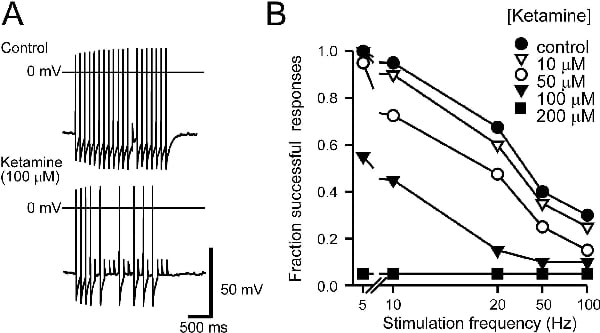The dissociative intravenous anaesthetic, ketamine, has recently been shown to inhibit nicotinic acetylcholine receptor (nAChR)-mediated currents in dissociated neonatal rat intracardiac ganglion (ICG) neurones (Weber et al. 2005). This effect would be predicted to reduce the excitatory post synaptic potential amplitude and depress synaptic transmission in the ICG and would account for the action of ketamine on peripheral vagal transmission to the heart (Inoue & Konig, 1988). We have investigated the actions of ketamine on postsynaptic responses to vagal nerve stimulation and exogenous ACh in adult rat ICG neurones. An isolated whole-mount preparation was used, comprising the right atrial ganglionic plexus and underlying myocardium. Intracellular recordings were made using sharp glass microelectrodes and the preparation was superfused with a bicarbonate buffered physiological salt solution maintained at 37°C. The effects of ketamine on synaptic transmission were investigated by applying trains of 20 stimuli at 5-100 Hz to the preganglionic nerve trunk. Ketamine attenuated postsynaptic action potential firing during each train in a concentration-dependent manner. This inhibition was more marked at higher frequencies (see Fig. 1). Attenuation of synaptic transmission in ICG was apparent at clinically relevant concentrations (10 μM), the fraction of suprathreshold responses being reduced to 0.62 (± 0.14 SD, n=3) of control values at 10 Hz by 100 μM ketamine. Focal application of ACh (100 μM, ≤10 ms) to ICG neurons evoked membrane depolarization and action potential discharge. This excitatory response was reversibly inhibited in a concentration-dependent manner by ketamine. Superfusion of ketamine (100 μM) reduced the excitatory response to exogenous ACh to 0.35 (± 0.10, n=3) of control depolarizing responses, but had no effect on the excitatory responses evoked by focal application of GABA (see Fischer et al. 2005). Taken together, ketamine inhibits ACh-induced responses and synaptic transmission in rat ICG and therefore attenuates the bradycardia observed in response to vagal stimulation in the mammalian heart.
University College London 2006 (2006) Proc Physiol Soc 3, PC156
Poster Communications: The action of the intravenous anaesthetic ketamine on ACh-evoked responses and synaptic transmission in rat intracardiac ganglia
Alexander A Harper1, Katrina Rimmer1, David J Adams2
1. Molecular Physiology, University of Dundee, Dundee, United Kingdom. 2. School of Biomedical Sciences, University of Queensland, Brisbane, QLD, Australia.
View other abstracts by:
Figure 1. Attenuation of postsynaptic events evoked by trains of nerve stimuli in the presence of ketamine. A responses to a train of 20 stimuli at 10Hz delivered to the preganglionic nerve trunk in control conditions and during superfusion of ketamine (100 μM). B depression of action potential firing recorded during repetitive stimuli with increasing concentrations of ketamine. The ratio of the number of suprathreshold responses to the number of stimuli was used to give an index of the frequency dependence of synaptic transmission.
Where applicable, experiments conform with Society ethical requirements.

